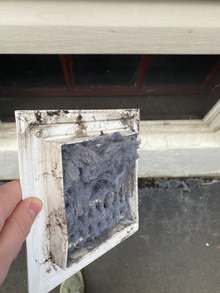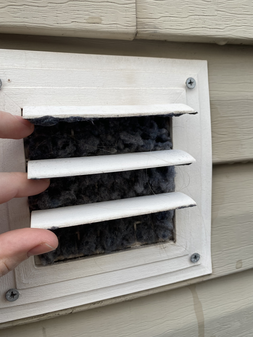Do I Need My Dryer Vent Cleaned?
You might be asking yourself, what and where is my dryer vent, and why do I need it professionally cleaned? A dryer vent is a crucial part of every dryer appliance. You can think of it essentially as an exhaust port for your dryer. When you run a dryer cycle, the appliance uses evaporation to dry your clothes by generating enough heat. This heat and moisture then needs somewhere to go, which is why a vent is needed on every dryer. You’ll see your dryer vent duct coming out of the back of your dryer – it’s a 4 inch pipe that leads to the outside of your home. The material that this duct is made out of may vary, however it’s most likely aluminum.
The heat and moisture generated from your dryer cycle aren’t the only things traveling through your dryer vent. As you know, dryers have a lint trap (which you should empty before or after every cycle!) to collect the lint that comes off your clothes during the cycle. Although the lint trap catches most lint that comes off your clothes, it can’t catch it all. This means that lint will inevitably travel up your dryer vent and build up over time. This contributes to the clogging of your dryer vent, along with other debris that may be left in pockets or attached to clothes. Over time, your dryer vent will clog up with use. This is a normal function, which is why routine dryer vent cleaning is a must. We recommend having your dryer vent inspected and cleaned at least once per year. For housing complexes or laundromats, this frequency increases to at least two or three times per year. There are multiple effects a clogged dryer can have, but the most important one is that the heat buildup inside a severely clogged dryer vent can cause a fire. Signs You Have a Clogged Dryer Vent
Your dryer takes longer than usual: One of the most common signals that your dryer vent needs a cleaning is when your clothes take longer than usual to dry. With a clogged vent, your dryer may take two, or even three cycles, to get your clothes completely dry. This is because the moisture that accumulates within the drum during the cycle has nowhere to go, thus, retreating back into your clothes.
Your clothes come out with an unpleasant smell: A clogged dryer vent can cause your clothes to smell after a cycle. This is often for the same reason why your dryer may take longer than usual to get your clothes dry: moisture builds up within the drum because it cannot escape through the vent as intended. Additionally, this may also lead to mold in your dryer. Your clothes are extremely hot to the touch or you smell burning: We all know that clothes will come out of the dryer warm – but if it hurts to touch them after a cycle, it’s probably time to look at your dryer vent. This is because the heat that your dryer uses to dry the clothes cannot escape the appliance. This can lead to a house fire and should be taken very seriously. Your dryer vent is visibly clogged: Dryer vents must exit your home, and often this port is always visible. You may see that the vent is clogged just from the amount of lint and debris in it – this is a telltale sign to get your dryer vent cleaned. Some dryer vents have flaps that open when air passes through them (when the dryer is running, the air from the vent pushes them open) and close when the appliance is off. If you run your dryer and see that these flaps are not opening as they should, then the vent is definitely clogged and should be professionally cleaned as soon as possible. |
Instant Quote$25 Discount Upon Completion! |
Risks of a Clogged Dryer Vent
Among the many consequences of failing to clean your dryer vent, the first and foremost is the risk of fire. A dryer works by generating heat to evaporate moisture from clothes. Then this heat along with moisture and lint is sent out the dryer vent to prevent buildup. When the dryer vent doesn’t let any air out, the heat will build up within the duct – and if you pair that with the flammable nature of lint and other debris that may be inside the dryer (such as receipts often left in pockets), a fire is imminent. Dryer fires cause thousands of fires each year, all because of clogged dryer vents. Thankfully, it’s easy to prevent this from happening. First, have your dryer vent professionally cleaned at least once per year. Also, you should empty the lint trap after each cycle.
Another big problem caused by failing to clean your dryer vent is that the life span of the appliance itself will be shortened. This is because of a couple reasons. Since a clogged dryer vent compromises the performance of the appliance, you’ll have to run it more, thus accelerating wear and tear on it. Also, the buildup of heat and debris causes extra stress to the appliance, also accelerating wear and tear.
You can also damage your clothes if you do not have a clean dryer vent. The buildup of heat within the drum can cause your clothes to burn, or it may give them an unpleasant smell.
Another big problem caused by failing to clean your dryer vent is that the life span of the appliance itself will be shortened. This is because of a couple reasons. Since a clogged dryer vent compromises the performance of the appliance, you’ll have to run it more, thus accelerating wear and tear on it. Also, the buildup of heat and debris causes extra stress to the appliance, also accelerating wear and tear.
You can also damage your clothes if you do not have a clean dryer vent. The buildup of heat within the drum can cause your clothes to burn, or it may give them an unpleasant smell.